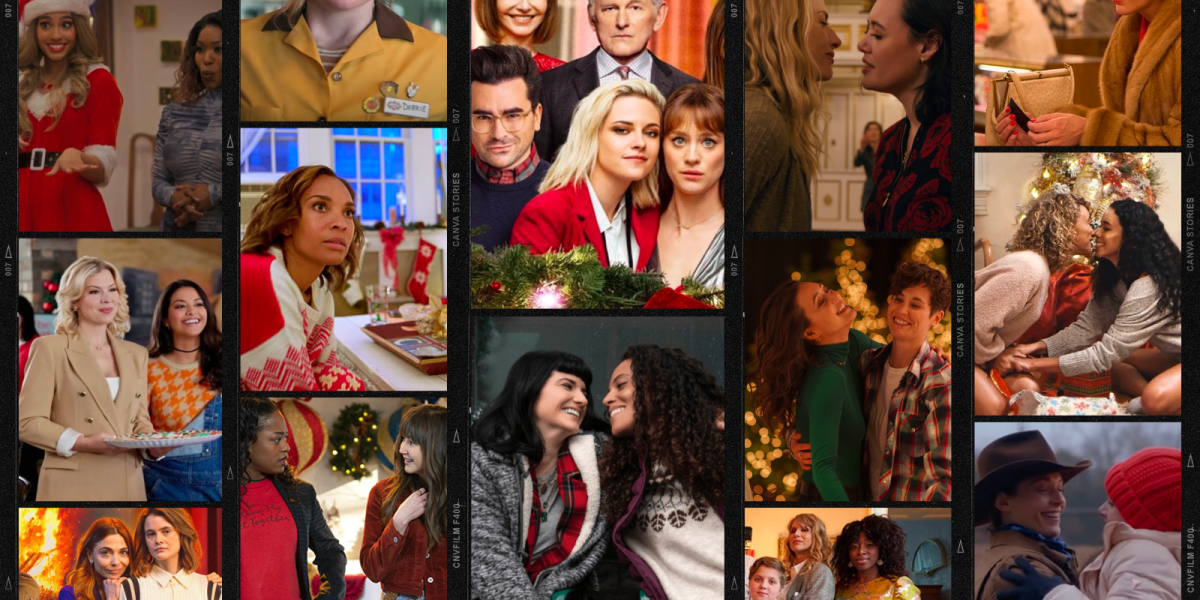![holigays-2013-banner[1]](https://develop.autostraddle.com/wp-content/uploads/2013/11/holigays-2013-banner1.jpg?resize=640%2C150)
Last year I put together a pretty fantastic Things I Read That I Love gift guide, which you should definitely check out because books are forever and I still think you should buy all of the books I told you to buy last year. All of the books in this guide, unless otherwise noted, are by authors whose work we’ve read in past Things I Read That I Love.
This gift guide is special because it’s sort of also a gift guide for the gifts you give yourself — chances are good you’re gonna be trapped in an airport somewhere for hours this holiday season, and you’ll need lots of kickass reading to keep you occupied. Luckily we’ve got you covered.
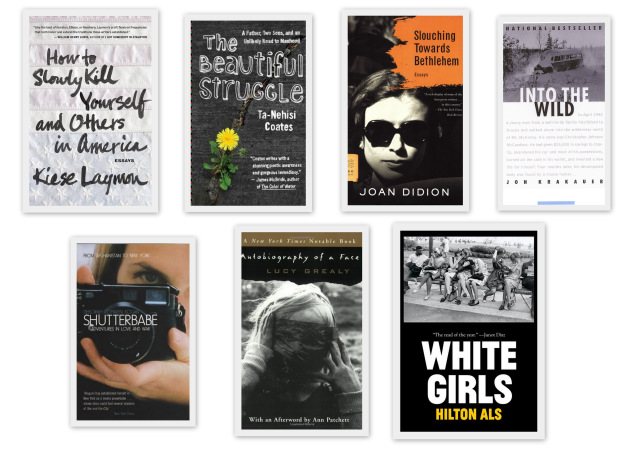
1. Kiese Laymon has been a breakout star in the literary world this year, and I’m not alone in wanting to furiously gobble up every word this man has written. The first piece of his I included in a TIRTL was “You are The Second Person,” from Guernica, and subsequent inclusions include How to Slowly Kill Yourselves And Others in America and The Worst of White People. His essay collection, How to Slowly Kill Yourself and Others in America, is a must-read must-own book of 2013.
2. You know Ta-Nehsi Coates from his work at The Atlantic, including May’s A Religion of Colorblind Policy. But did you know that he wrote a book also, because he did and it’s called The Beautiful Struggle: A Father, Two Sons, and an Unlikely Road to Manhood.
3. Obviously Joan Didion is one of my favorite non-fiction writers ever, and this year I made you read her essay Some Dreamers of the Golden Dream. If you liked that, you’d probs like the anthology it’s published in — Slouching Towards Bethlehem: Essays.
4. Jon Krakauer is always a shoo-in for lists like this— specifically, his book Under the Banner of Heaven: A Story of Violent Faith, the longer version of the essay we read in Byliner some time back, and Into the Wild, which Krakauer effectively “updated” this year in The New Yorker to reveal new details discovered recently about Christopher Johnson McCandless, who died alone while on a solo journey in Alaska. The essay which became Into the Wild, Death of an Innocent, is available in its entirety on The New Statesman.
5. In My So-Called Post-Feminist Life In Arts and Letters, published this April in The Nation, Deborah Copaken Kogan discusses the omnipresent sexism that dominated her entire experience in publishing, including the launch of her best-known book, Shutterbabe: Adventures in Love and War, which is the story of her early years as a photojournalist. In the aforementioned article, Kogan says that Shutterbabe was not her choice of title, but at least one the struggle over the cover art, which the publishers wanted to be a “naked cartoon torso against a pink background with a camera covering the genitalia.” But aside from all that, it’s still a great book.
6. Oh, Mirrorings was so sad and haunting, maybe you remember it. It’s by Lucy Grealy who died in 2002 of a heroin overdose and before that wrote the 1994 bestseller Autobiography of a Face, about her experiences with facial disfigurement resulting from cancer of the jaw.
7. Wasn’t Hilton Als‘ Guernica essay White Girls so good? It was so good. You know what else I bet is so good? The book: White Girls which “finds one of The New Yorker’s boldest cultural critics deftly weaving together his brilliant analyses of literature, art, and music with fearless insights on race, gender, and history.”

1. We’ve read a few Robert Kolker pieces in TIRTL, like Cheating Upwards, Kaboom and A Daughter’s Revenge. The New York Magazine story A Serial Killer in Common, also by Kolker, is in this week’s TIRTL, and that case (a serial killer of prostitutes in Long Island) is also the topic of his book Lost Girls: An Unsolved American Mystery.
2. It’s not surprising that Stacy Mitchell wrote this year’s Alternet article Wal-Mart’s Death Grip on Groceries is Making Life Worse For Millions Of People — she’s also written a whole book on the topic, entitled Big-Box Swindle: The True Cost of Mega-Retailers and the Fight for America’s Independent Businesses.
3. Kate Losse wrote a killer takedown of Lean In this year for Dissent, entitled Feminism’s Tipping Point: Who Benefits From Leaning In. Her experiences working at Facebook shaped that essay as well as her acclaimed non-fiction book, The Boy Kings: A Journey into the Heart of the Social Network.
4. Okay I’m breaking for one moment from the “all these books are by authors who we’ve featured in TIRTL” theme to say that if you liked reading about Tonya Harding in TIRTL, perhaps you would enjoy Little Girls in Pretty Boxes: The Making and Breaking of Elite Gymnasts and Figure Skaters, by Joan Ryan! I sure did.
5. Radio commentator and performer Sandra Tsing Loh‘s takedown of Jonathan Kozol, Tales Out Of School, was quite epic and convincing, and I say this as somebody whose life was profoundly changed by Jonathan Kozol’s Savage Inequalities. Her memoir Mother on Fire: A True Motherf%#$@ Story About Parenting! promises lots of laughs out loud from “the fiercest, funniest, and most incredibly honest voice to emerge from the “mommy war” debates.”
6. We read an excerpt from Nick Turse‘s Kill Anything That Moves: The Real American War in Vietnam in Alternet in January, entitled Gang Rapes and Beatings, Brothels Filled With Teenage Prostitutes — The Depth of American Brutality in Vietnam. By all reports, the story is thorough and disturbing, drawing on over a decade of research and interviews with American and Vietnamese survivors, revealing that “violence against Vietnamese noncombatants was not at all exceptional during the conflict. Rather, it was pervasive and systematic, the predictable consequence of orders to “kill anything that moves.”
7. We read Anna Clark‘s American Prospect piece Is Suze Orman’s Advice Dangerous in January. Clark knew what she was talking about because she’s also the author of Pound Foolish: Exposing the Dark Side Of The Personal Finance Industry.
8. I picked up Alan Sepinwall‘s The Revolution Was Televised: The Cops, Crooks, Slingers, and Slayers Who Changed TV Drama Forever after reading the chapter about LOST that was published in Grantland last year, called I Pretty Much Wanted to Die. It’s a great book, I recommend it!
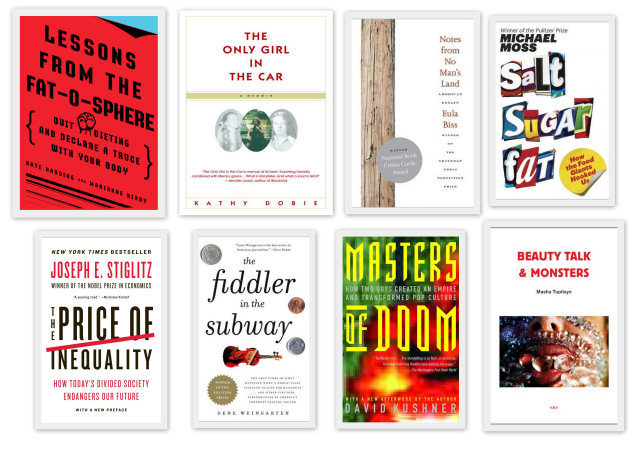
1. Marianne Kirby‘s Bitch Magazine story, Co-opting the Coop, about the rise of urban homesteading and its inability to recognize that for many lower-income people, homesteading is simply a survival skill, not an alternative lifestyle trend, was pretty awesome. The book she co-wrote with Kate Harding of Shapely Prose, Lessons from the Fat-o-sphere: Quit Dieting and Declare a Truce with Your Body, is undoubtedly ALSO pretty effin’ awesome.
2. Kathie Dobie, author of At Trail’s End, a 2011 GQ essay about the horrifying gang rape of an 11-year-old girl in Texas, also wrote a memoir, entitled The Only Girl in the Car, about her own experience as a survivor — in the 1960s, 14-year old Dobie, who lived with her large Catholic family in a small Connecticut town, was gang raped by her steady boyfriend and three of his friends. “She’s ostracized so badly, she can’t confide in her closest girlfriends, much less her family,” writes Publisher’s Weekly. “Slowly she recovers by “remaking” herself as a loner, as a writer. Like many coming-of-age stories, Dobie’s is painful, in large part because of the cultural cusp her generation of women had to navigate. Sexual liberation was celebrated-even the youth center director talked with the teens while she dallied in bed with her boyfriend-but girls with reputations were doomed.”
3. Eula Biss, author of The Believer essay No Man’s Land: Fear Racism, and the Historically Troubling Attitude of American Pioneers, published an essay collection in Notes from No Man’s Land: American Essays in 2009. The book earned the National Book Critics Circle Award for Criticism and the Graywolf Press Prize for Nonfiction. The School Library Journal writes that it “explores race in America through multiple lenses, examining common issues through uncommon situations and events. She flawlessly weaves present-day experiences with historical research to create 13 essays that combine narrative appeal with fascinating facts.”
4. If you liked Michael Moss‘ New York Times Magazine cover story The Extraordinary Science of Addictive Junk Food, you would really like his book Salt Sugar Fat: How the Food Giants Hooked Us.
5. Joseph E. Stiglitz, author of May 2012’s Vanity Fair essay The 1 Percent’s Problem and a Nobel Prize winning economist, expanded on the details of how our economy is blowing its own foot off in The Price of Inequality: How Today’s Divided Society Endangers Our Future.
6. Gene Weingarten wrote a lot of the essays we’ve read, such as Fatal Distraction (the Pulitzer-Prize winner about children who died after being accidentally left in hot cars by their parents), Why Not the Worst? and The Great Zucchini.These and more can be enjoyed at length in The Fiddler in the Subway: The Story of the World-Class Violinist Who Played for Handouts. . . And Other Virtuoso Performances by America’s Foremost Feature Writer.
7. David Kushner, author of the 2003 piece I Was A Teenage Freak, about a town in Florida populated by circus sideshow performers, has written a lot of books, such as Masters of Doom: How Two Guys Created an Empire and Transformed Pop Culture.
8. Masha Tupitsyn, author of January’s Johnny & Winona (Die With Me) for Berfrois, has also written several books. Bookslut had this to say about Masha Tupitsyn’s Beauty Talk & Monsters: “Masha Tupitsyn’s debut collection is a breathtaking mixture of tall tale and autobiography, film theory and lover’s lament, traveler’s diary and gender treatise. A novel-in-parts disguised as a bootleg memoir crossed with a Hollywood tell-all, Beauty Talk & Monsters dares us to ask if there is a point to reliability when a shifty narrator can provide so much obsessive insight… Beauty Talk & Monsters has a shimmering intimacy.”
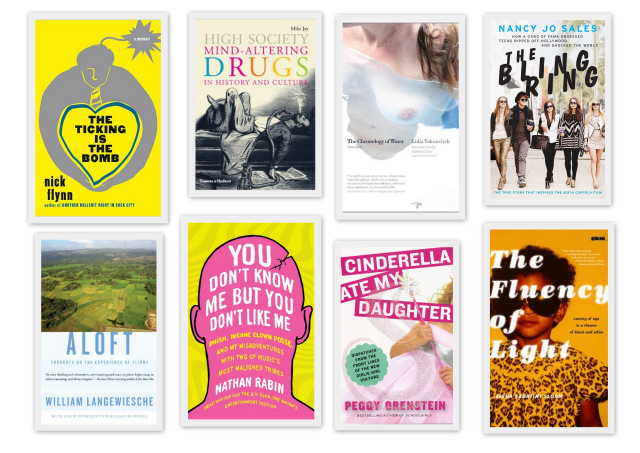
1. Nick Flynn‘s Esquire essay pulled from this book is absolutely stunning, so the whole entire book, The Ticking Is the Bomb: A Memoir, is probably also perfect. Here’s the description: “In 2007, during the months before Nick Flynn’s daughter’s birth, his growing outrage and obsession with torture, exacerbated by the Abu Ghraib photographs, led him to Istanbul to meet some of the Iraqi men depicted in those photos. Haunted by a history of addiction, a relationship with his unsteady father, and a longing to connect with his mother who committed suicide, Flynn artfully interweaves in this memoir passages from his childhood, his relationships with women, and his growing obsession—a questioning of terror, torture, and the political crimes we can neither see nor understand in post-9/11 American life.”
2. Mike Jay is the author of Aeon’s The Reality Show about how schizophrenics’ delusions have changed over time from demons and spirits to actors and hidden cameras and the CIA. He’s also written some books, for example, High Society: The Central Role of Mind-Altering Drugs in History, Science, and Culture.
3. If you liked Lidia Yuknavitch‘s Rumpus essay Explicit Violence, perhaps you would also like The Chronology of Water: A Memoir, her memoir, described like this: “a lifelong swimmer and Olympic hopeful escapes her raging father and alcoholic and suicidal mother when she accepts a swimming scholarship which drug and alcohol addiction eventually cause her to lose. What follows is promiscuous sex with both men and women, some of them famous, and some of it S&M, and Lidia discovers the power of her sexuality to help her forget her pain. The forgetting doesn’t last, though, and it is her hard-earned career as a writer and a teacher, and the love of her husband and son, that ultimately create the life she needs to survive.”
4. You’ve probably heard of Nancy Jo Sales‘ The Bling Ring: How a Gang of Fame-Obsessed Teens Ripped Off Hollywood and Shocked the World even if you didn’t read the 2010 Vanity Fair article the book began as, The Suspects Wore Louboutins, which I posted in TIRTL this past June. You’ve probably heard of it because you know, they made a movie about it.
5. William Langewiesche‘s Vanity Fair essay The Devil at 37,000 Feet was an insanely gripping and educational account of a 2008 plane crash in Brazil, as was The Crash of Egypt Air 990 for The Atlantic. Langewiesche apparently writes a lot of things about flying! In Aloft, Langewiesche “considers how flying has altered not only how we move about the earth, but also how we view our world and our place in it. With vivid descriptions of the aesthetics and excitement of flight, he also writes of the risks that go with this beauty: the perils of air traffic control, and the dangers of nervous passengers and bad weather.”
6. Nathan Rabin wrote Strange Times at the 2012 Gathering of the Juggalos for The AV Club and you can read all of his Insane Clown Posse and Phish adventures in, exists in this book You Don’t Know Me but You Don’t Like Me: Phish, Insane Clown Posse, and My Misadventures with Two of Music’s Most Maligned Tribes.
7. Peggy Orenstein wrote Schoolgirls: Young Women, Self-Esteem and the Confidence Gap, the book that inspired me, at the age of 13, to decide then-and-there that as soon as I figured out how to harness some self-confidence for myself, I wanted to dedicate my life to making women feel better about themselves. This year, Orenstein was featured in TIRTL for her New York Times Magazine article Our Feel-Good War Against Breast Cancer. Her most recent book is Cinderella Ate My Daughter: Dispatches from the Front Lines of the New Girlie-Girl Culture, for which “She visited Disneyland and the international toy fair, trolled American Girl Place and Pottery Barn Kids, and met beauty pageant parents with preschoolers tricked out like Vegas showgirls. She dissected the science, created an online avatar, and parsed the original fairy tales. The stakes turn out to be higher than she—or we—ever imagined: nothing less than the health, development, and futures of our girls.”
8. Aisha Sabatini Sloan, who wrote A Clear Presence for Guernica about the Rodney King riots and Los Angeles and David Hockney and Chirstopher Dorner and racism, published her debut collection this past may, The Fluency of Light: Coming of Age in a Theater of Black and White. In it, Sloan “examines the experience of her mixed-race identity” in “intertwined essays on art, music and identity.”
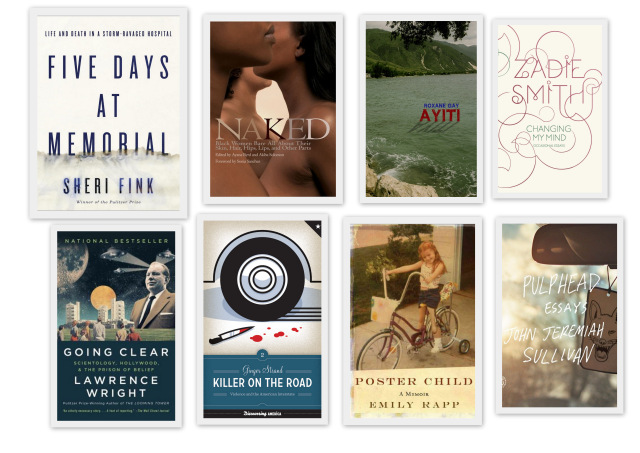
1. Sheri Fink’s The Deadly Choices at Memorial Medical Center During and After Katrina was one of the most acclaimed works of journalism of the past five years (it even won a Pulitzer!). I would imagine that the book is also pretty effing awesome. In Five Days at Memorial: Life and Death in a Storm-Ravaged Hospital, Fink “reconstructs 5 days at Memorial Medical Center and draws the reader into the lives of those who struggled mightily to survive and to maintain life amid chaos.”
2. Akiba Solomon did a piece for Colorlines this year about The Missionary Movement to ‘Save’ Black Babies. She’s also the editor of the essay collection Naked: Black Women Bare All About Their Skin, Hair, Hips, Lips, and Other Parts, which features 25 “candid and provocative” essays from black women about beauty, body image, and the popular conception of the black female body — there’s even essays from Kelis and Jill Scott!
3. Ayiti is the debut collection of stories, poetry and non-fiction interwoven to represent the Haitian diaspora experience by Roxane Gay, who you probably already love for her writing on The Rumpus and elsewhere, and the many pieces of hers featured in TIRTLs, such as The Illusion of Safety/The Safety of Illusion and Spit & Mud.
4. Oh, Zadie Smith! I recommended Zadie Smith last year and now I am doing it again, for any of y’all who enjoyed Joy when we read it in January, for sure check out Changing My Mind: Occasional Essays.
5. The New Yorker‘s The Apostle: Paul Haggis Vs. The Church of Scientology turned out to be the first of many stories from inside the church — something widely considered impossible back in 2011 when the church still had a vice grip on litigation that scared everybody out of writing about them. Lawrence Wright‘s Going Clear: Scientology, Hollywood, and the Prison of Belief is the critically acclaimed “whole story” based on years of archival research and over 200 interviews with current and former Scientologists.
6. We read Ginger Strand‘s Drive-By Truckers, about serial killers who are truck drivers, in 2012. Apparently she wrote an entire book on the subject of murder and the road: Killer on the Road: Violence and the American Interstate (Discovering America).
7. Emily Rapp, author of “Grief Magic,” wrote her memoir Poster Child in 2008, about her experiences growing up with a congenital defect that required amputating her entire leg below the knee and other operations, making her “the smiling, always perky, indefatigable poster child for the March of Dimes.” As described on Amazon, the memoir is an “unflinching, brutally honest and often darkly humorous account of wrestling with the tyranny of self-image as a teenager and then ultimately coming to terms with her own body as a young woman.”
8. John Jeremiah Sullivan‘s Pulphead: Essays contains “an exhilarating tour of our popular, unpopular, and at times completely forgotten culture.” Perhaps you recall his essay about visiting a Christian Rock festival in a giant RV, Upon This Rock, which was very entertaining, or Feet in Smoke, his essay for The Oxford American about his brother getting electrocuted by a microphone.
Related Reading
If you like TIRTL because you like good quality non-fiction, then these celebrated reads of 2013 might be up your alley even though they aren’t by authors we’ve read this year.
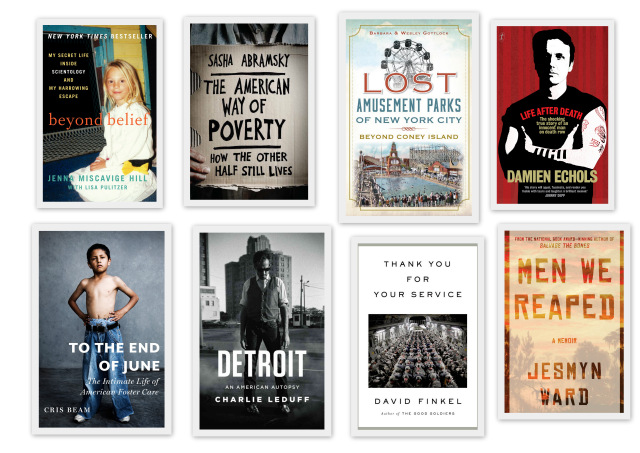
1. If you enjoyed reading about scientology, give Beyond Belief: My Secret Life Inside Scientology and My Harrowing Escape, written by Jenna Miscavige Hill, the daughter of Scientology leader David Miscavige
2. If you wanna read more about poverty in America and how everything is terrible, try The American Way of Poverty: How the Other Half Still Lives, by Sasha Abramsky.
3. If you enjoyed reading about failed amusement parks like Freedomland, maybe take a gander at Lost Amusement Parks of New York City: Beyond Coney Island.
4. If you are intrigued by the stories of ‘The West Memphis Three,” check out Damien Echols‘ memoir, Life After Death.
5. If you wanna read more about foster care, check out To the End of June: The Intimate Life of American Foster Care, by Cris Beam.
6. If you liked reading about Detroit, try New York Times Bestseller Detroit: An American Autopsy by Charlie LeDuff.
7. If you’re interested in the aftereffects of war on the soldiers who fought it, you will be interested in David Finkel’s Thank You for Your Service.
8. If you’re in the market for outstanding personal nonfiction which also indicts society and race relations at large, try one of this year’s most acclaimed books, Men We Reaped: A Memoir by Jesmyn Ward.
9. If you were compelled by reading about prison and criminal justice reform, I suggest Michelle Alexander’s The New Jim Crow: Mass Incarceration in the Age of Colorblindness (This book actually came out in 2012 but I will never stop recommending it so.)
Reading Devices
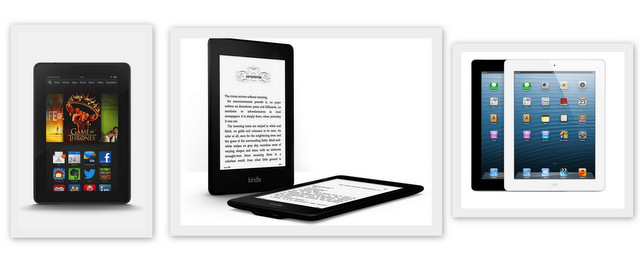
Finally, if you like to read things, it helps to have a thing to read them on. I read all these articles by saving them to Instapaper and then reading them from my iPad. I also use the Longform App for iPad to find more things to read.
I got my iPad as a gift two years ago and it was basically the best thing to ever happen to me since I got my Samantha doll for my 8th birthday. I’m not very tech-savvy so I don’t really know the difference between different generations of iPads, but I find this 16 GB Apple iPad 2 to be a delightful machine though I hear new ones are being released with startling regularity. The Apple iPad Minis seem super-cute.
I actually started reading so many things when I got one of the really early Kindles. I eventually got a first generation Kindle Fire HD, which you can get now for the low-low price of $139. Or you can be really fancy with the $229 Kindle Fire HDX. The Kindle Paperwhite is also a great choice if you just need a tablet for reading. Its display is easy to read in all kinds of light situations according to the commercials I’ve seen for it on the television.
Well that about does it! One last tip: TIRTL fans are almost guaranteed to enjoy year-end anthologies, like Best American Magazine Writing 2013, The Best American Essays 2013 and The Best American Nonrequired Reading 2013. So there’s always that. Thanks for reading and have a very happy holiday!






